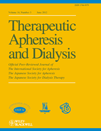Upper Limb Disability in Hemodialysis Patients: Evaluation of Contributing Factors Aside From Amyloidosis
Abstract
This cross-sectional case-control study evaluated upper limb muscle strength and shoulder mobility in hemodialysis (HD) patients with arteriovenous fistula or graft. Twenty-five adult patients on thrice-a-week HD treatment for 6 months at least, were selected for the study. In all the patients and control subjects, handgrip tests and tests of range of motion in the upper extremities were evaluated by physiotherapy tests. Patients on HD showed lower muscle strength than age and sex matched subjects without severe chronic kidney disease (right: 30.1 ± 11.6 vs 40.5 ± 15.1 kg, P < 0.001; left 29.1 ± 12.9 vs 40.7 ± 11.1 kg, P < 0.01), and a reduced range of shoulder mobility. The presence of fistula or graft was associated with a greater limitation of both active (74.0 ± 18.3 vs 85.2 ± 8.8 °, P < 0.01) and passive (82.2 ± 9.9 vs 87.2 ± 6.6 °, P < 0.05) extra-rotation than the contralateral limb, with a higher prevalence of impingement (72 vs 36%, P < 0.05). Muscle strength was related to albumin and inversely to age; whereas β2-microglobulin and CRP serum levels were associated with impairment of passive and active extra-rotation of the shoulder that was free from the fistula or graft. In summary, patients on HD have a reduced range of shoulder mobility and marked reduction of muscle strength. The abnormalities are more prevalent in upper limbs with fistula or grafts. The arteriovenous fistula or graft may worsen the disability of the patient's upper limbs presumably due to the obligate position required during the HD sessions. Proper pre- and post-dialysis exercise programs should be implemented to maintain mobility and strength of the upper limbs.




